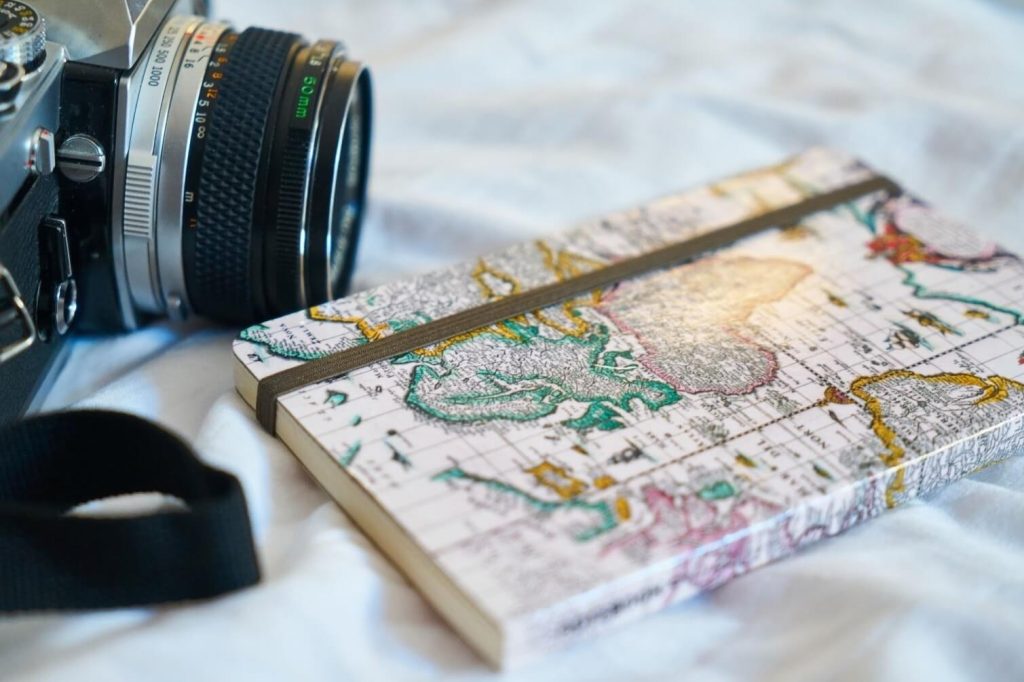Documenting travel experiences has become a cherished way to preserve memories and share adventures. While “travel journal” and “travel diary” are often used interchangeably, they have distinct purposes and styles. This blog explores their key differences to help you choose the best approach for capturing your journeys.
What is a Travel Journal?
A travel journal is a reflective and creative way to documenting travel experiences. It goes beyond merely recording events; instead, it focuses on capturing the essence of a journey through personal insights and artistic expression.
Definition and Purpose
A travel journal serves as a canvas for storytelling, allowing travelers to document their thoughts, emotions, and observations. It provides a deeper connection to the journey and encourages reflection on the cultural, historical, and personal significance of the places visited.
Key Features
Travel journals often incorporate creative elements such as sketches, photographs, pressed flowers, or ticket stubs. They delve into detailed reflections on memorable moments, whether it’s the feeling of standing before a historic monument or the taste of a unique dish.
Examples of Use
- Narrating a trek through a remote mountain range, describing the challenges and rewards.
- Reflecting on the cultural significance of a festival attended in a foreign country.
- Capturing the emotions evoked by a serene sunset or bustling market scene.
What is a Travel Diary?
In contrast, a travel diary is more of a chronological and factual record of a trip. It focuses on the logistical aspects, creating a day-by-day account of activities and experiences.
Definition and Purpose
A travel diary is designed to log the details of a trip in a systematic way. It acts as a practical record, capturing essential information and a straightforward account of daily happenings.
Key Features
Entries in a travel diary are typically concise, focusing on dates, times, locations, and brief descriptions of events. It may also include practical details such as costs, schedules, or weather conditions, making it a useful reference for future trips.
Examples of Use
- Logging a daily itinerary, including places visited and activities completed.
- Noting the names of restaurants, the meals enjoyed, and their cost.
- Recording significant encounters or notable travel tips learned along the way.

Key Differences Between a Travel Journal and a Travel Diary
While both serve to document travel experiences, the approach and purpose of a travel journal and travel diary differ significantly.
Format and Structure
A travel journal is free-form and narrative, allowing for creativity and flexibility in documenting experiences. In contrast, a travel diary is more structured and sequential, adhering to a chronological order that focuses on details.
Content Focus
Travel journals emphasize reflections, emotions, and creative storytelling. They are ideal for travelers who want to capture the essence of their journey through vivid descriptions and artistic elements. Travel diaries, on the other hand, focus on facts and chronology, making them perfect for travelers who prefer to record practical details and daily occurrences.
Purpose and Usage
The purpose of a travel journal is to preserve memories and tell stories that resonate on a deeper level. It serves as a keepsake to revisit and relive the emotional and cultural aspects of the journey. A travel diary, meanwhile, acts as a personal log or practical reference, useful for recalling specific details about the trip or planning future adventures.
Choosing Between a Travel Journal and a Travel Diary
Choosing between a travel journal and a travel diary depends on your personal preferences and what you hope to achieve from documenting your travels.
Identifying Your Goals
If your primary aim is to capture the emotions, insights, and unique moments of your journey, a travel journal might be the best fit. Journals allow you to explore the cultural and personal significance of your experiences through creative storytelling. On the other hand, if you prefer a straightforward record of events and practical details, a travel diary will suit your needs better, offering a clear and organized way to track your journey.
Consider Your Writing Style
Your natural writing style can guide your choice. Creative individuals who enjoy vivid descriptions, sketches, or photography might find a travel journal more engaging. In contrast, those with a detail-oriented mindset, who enjoy cataloging dates, times, and specific locations, may gravitate toward a travel diary.
Hybrid Approaches
For travelers who can’t decide between the two, combining elements of both can be an excellent solution. For instance, you could maintain a diary to record logistical details and daily events while dedicating sections to reflective journal-style entries. This hybrid approach provides a comprehensive and balanced record of travels.

Tips for Creating Travel Record
Whether you choose a travel journal, a travel diary, or a combination of both, these tips can help you create meaningful and consistent travel records.
Travel Journals
- Enhance Creativity: Incorporate sketches, photos, or keepsakes like ticket stubs and pressed flowers to make your journal visually appealing.
- Reflect on Experiences: Write about cultural observations, emotions, and personal lessons learned from your journey.
- Tell a Story: Use descriptive language and anecdotes to bring your experiences to life for future readers, including yourself.
Travel Diaries
- Stay Concise: Keep entries brief and to the point, focusing on dates, locations, and activities.
- Include Practical Details: Record addresses, budgets, transportation schedules, and notable encounters to create a useful reference for future trips.
- Stay Organized: Use a consistent format for each entry to make your diary easy to review.
Maintaining the Habit
Consistency is key to a meaningful travel record. Dedicate a specific time each day to update your journal or diary, such as before bed or during a quiet moment in the morning. If you struggle with writer’s block, use prompts or templates to guide your entries, such as “What surprised me most today?” or “My favorite moment of the day was…”.

Benefits of Documenting Travel Experiences
Recording your travels goes beyond creating a keepsake; it offers several lasting benefits.
Memory Preservation
A well-documented travel record serves as a time capsule, allowing you to relive your adventures long after they’ve ended. It captures the details that might otherwise fade over time, keeping the essence of your journey alive.
Personal Growth
Reflecting on your travels fosters self-awareness and cultural appreciation. Writing about your experiences can help you process emotions, recognize personal growth, and understand the perspectives of others.
Sharing with Others
Travel records can inspire and inform others, whether through sharing stories with friends and family or providing practical tips for future travelers. They can also serve as a resource for blogs or social media content, allowing you to connect with a broader audience.
Conclusion
Travel journals and travel diaries offer unique ways to document your adventures, each catering to different styles and goals. Choose the method that aligns with your preferences, or blend the two for a balanced approach. Start documenting your journeys today to preserve memories, reflect on experiences, and inspire future travels.

